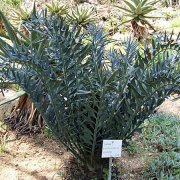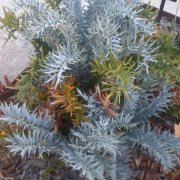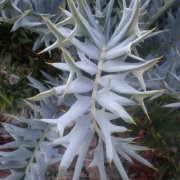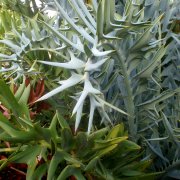Care of the cycad Encephalartos horridus or African Blue Cycad |
|
The genus Encephalartos, family Zamiaceae, comprises 60 species of cycads native to Africa. Some species are: Encephalartos horridus, Encephalartos ferox, Encephalartos altensteinii, Encephalartos senticosus, Encephalartos natalensis, Encephalartos villosus, Encephalartos lebomboensis, Encephalartos lehmannii, Encephalartos transvenosus, Encephalartos aemulans, Encephalartos paucidentatus. Common names: African Blue Cycad, Eastern Cape blue cycad. This species is native to Eastern Cape Province, South Africa. They are small cycads that reach 90 cm (2.95 feet) in height. The attractive arched leaves are composed of bluish-green spiny leaflets. The female cones are ovoid and the male ones are cylindrical. African Blue Cycad is used as isolated specimens or in groups in gardens away from places of passage to avoid thorns. It's suitable for growing in pots. Encephalartos horridus can grow in direct sunlight or light shade exposure. It is better not to expose it to frost. The soil must have excellent drainage and contain organic matter because it prefers acidic soil. Eastern Cape blue cycad is a plant resistant to drought; water moderately waiting for the soil to dry out. Fertilize in early spring with compost or humus. Prune damaged or dry leaves. African Blue Cycad is a plant resistant to pests and diseases; they only fear excess moisture. It's better to buy new specimens in nurseries or garden centers; propagation by seeds is very slow and from the suckers it's not a simple process. |
Images of the cycad Encephalartos horridus or African Blue Cycad |
Find plants
Encephalartos horridus or African Blue Cycad | Care and Growing
© 2026 FavThemes



